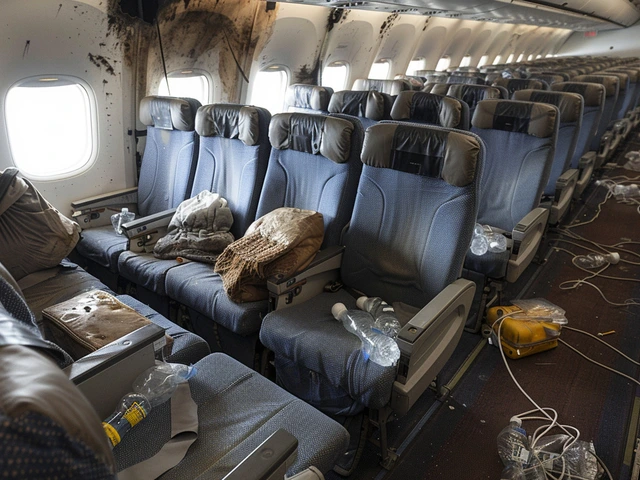
Fatal Turbulence on Singapore Airlines Flight from London
Fatal Turbulence on Singapore Airlines Flight from London
In an alarming incident, a Singapore Airlines flight traveling from London to Singapore encountered severe turbulence, leading to the tragic death of one passenger and leaving several others injured. The unexpected bout of turbulence forced the Boeing 777-300ER aircraft, which was en route to Changi Airport in Singapore, to divert and make an emergency landing at Suvarnabhumi Airport in Bangkok. This incident has raised numerous questions about flight safety and the unpredictable nature of turbulence.
The Unfolding of the Incident
The turbulence struck without warning during what was supposed to be a routine flight between two major global cities. Passengers on board the aircraft, whose exact number has not been disclosed, reported an intense jolt that shook the plane violently. According to eyewitness accounts, the cabin was thrown into chaos as items, meals, and personal belongings were hurled around the cabin. Some passengers were reported to have been thrown out of their seats, causing serious injuries. Despite the sometimes routine nature of turbulence, this incident highlights how dangerous it can become under severe conditions.
In response to the tumultuous conditions, the flight crew quickly assessed the situation and made the critical decision to divert to the nearest available major airport, which in this case, was Suvarnabhumi Airport in Bangkok. This decision was made to prioritize the safety and wellbeing of all passengers and crew members on board. Emergency response teams were ready and waiting at the Bangkok airport, prepared to render immediate medical assistance and take stock of the situation.
Immediate Aftermath and Response
Upon landing, the injured passengers were swiftly evacuated and taken to nearby medical facilities for treatment. The tragic death of one passenger was confirmed by authorities, adding a somber note to what was already a harrowing experience. The status of the injured passengers remains unclear as they receive medical care, with some reportedly holding out hope for full recovery while others are in more critical condition.
Singapore Airlines has issued an official statement expressing their condolences to the family of the deceased and their commitment to supporting all affected passengers. The airline affirmed that they are cooperating fully with aviation authorities to investigate the incident and understand what measures could be put in place to prevent a recurrence. The flight crew's actions, aimed at protecting lives by diverting to Bangkok, have been lauded for their professionalism and quick thinking under pressure.
Turbulence and Flight Safety: An Ongoing Concern
Turbulence, a common atmospheric occurrence, can vary in intensity and typically does not lead to significant harm. However, severe turbulence can be extraordinarily dangerous, as evidenced by this incident. Turbulence is caused by air currents moving at varying speeds and directions, often undetectable until encountered. Even the most advanced aviation technology cannot predict turbulence with complete accuracy, making it a persistent challenge for the aviation industry.
This event has reignited discussions among aviation experts about enhancing predictive technology and improving passenger safety protocols. Standard recommendations for passengers, such as keeping seat belts fastened when seated, are vital, as this incident demonstrates. While airplanes are designed to withstand significant stress caused by turbulence, the human element within the cabin remains vulnerable.
Investigation and Future Protocols
The incident is currently under a comprehensive investigation by both Singapore Airlines and international aviation regulatory bodies. The aim is to analyze all aspects of the flight, from weather conditions to in-flight procedures and the response by the flight crew. Such investigations are routine in the wake of serious incidents and are crucial for developing enhanced safety measures. Preliminary insights often lead to improved training for flight crews and modifications in protocols that may reduce the likelihood of similar future occurrences.
As the investigation continues, aviation authorities may look into the flight path and any weather anomalies that were present at the time. The role of real-time weather tracking systems and how effectively they were used will also be scrutinized. There remains ongoing interest in whether any advancements in turbulence detection could be integrated into commercial flights to provide better anticipatory guidance.
Passengers' Experiences and Airline's Support
Passengers aboard the flight have recounted their experiences with varying degrees of shock and trauma. For many, the sudden violent movements shattered any sense of security typically associated with air travel. The psychological impact of such an event can be substantial, leading to lasting fear and anxiety about future travel. Singapore Airlines has taken measures to offer both medical and emotional support to their passengers, recognizing the broad scope of care required in the wake of such incidents.
Support systems put in place include access to counseling services, clear communication channels for updates, and any necessary logistical assistance, such as rebooking flights and accommodation. The airline's efforts to reach out to passengers' families and provide timely information have been critical in managing the aftermath of the event. The emphasis on compassionate care and transparent communication is pivotal in maintaining trust and confidence among passengers.
Looking Forward: Enhancing Air Travel Safety
The tragic event on this Singapore Airlines flight serves as a stark reminder of the unpredictable dangers of air travel, despite the industry’s significant safety advances. Innovations in aircraft design, predictive weather technologies, and passenger safety protocols will continue to evolve in response to such incidents. The collaboration between airlines, regulatory authorities, and technological experts remains essential to ensuring that air travel remains one of the safest modes of transportation.
While the investigation is yet to be concluded, this incident underscores the necessity for ongoing vigilance, proactive safety measures, and continual improvement within the aviation sector. Passengers and airlines alike must remain aware of the best practices to navigate the challenges posed by unforeseen flight conditions, such as severe turbulence. Only through a concerted effort can the industry hope to mitigate the risks and forge a path toward safer skies.
In conclusion, the fatal turbulence on this Singapore Airlines flight is a poignant reminder of the inherent risks in aviation. The dedication of flight crews, the prompt emergency response, and the thorough investigations that follow are all critical components of ensuring passenger safety. Advances in technology and safety protocols must continue to adapt and improve, reflecting the dynamic and ever-changing nature of air travel.






